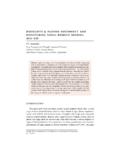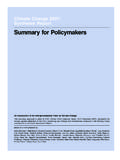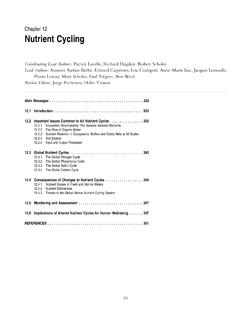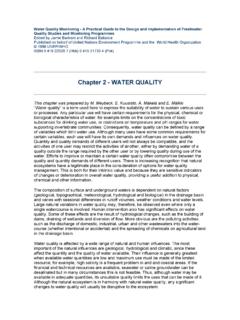Transcription of Monitoring and Assessment of Chemical Quality Session ...
1 WHO SEMINAR PACK FOR DRINKING-WATER QUALITYM onitoring and Assessment of Chemical QualitySession objectives To highlight the relative priority for microbiological and Chemical water Quality Monitoring and emphasis the need for a rational, health-based approach to Monitoring of water Quality . To outline the key characteristics of Monitoring programmes which may be implemented for Chemical water Quality . To describe the analytical ranges commonly employed in Chemical water Quality Monitoring , highlight key constraints in Chemical analysis and stress the need for Quality control.
2 To emphasis the value of risk Assessment as a key supporting activity of Chemical analysis and in planning Monitoring programmes. 1 Monitoring and Assessment of Chemical Quality IntroductionChemical testing is generally not undertaken as frequently as microbiological analysis because, in general, the health risks posed by chemicals are chronic rather than acute and because changes in water chemistry tend to be longer-term unless a specific pollution event has occurred. It should be stressed that Monitoring the microbiological Quality of water is much more important than Monitoring of Chemical Quality and Chemical testing should generally be a lower priority.
3 However, where resources permit, routine testing of the Chemical Quality of water should be undertaken. Priority should be given to those substances which are known to be of importance to health and which are known to be present in significant concentrations in drinking-water. For instance, the Monitoring of nitrate is recommended in many water supplies and in particular those which are located in rural areas, or where recharge occurs in an agricultural area. In these circumstances, regular Monitoring is recommended to ensure that early warning of increases is noted or when nitrate releases are highly seasonal in nature.
4 An Assessment of the Chemical Quality of water should be undertaken during source selection and this should relate to known activities within the catchment of the source and possible natural pollutants. This should be as comprehensive as possible and cover a wide range of pollutants. In areas where toxic chemicals are released into the aquatic environment, routine Monitoring should be undertaken and closely linked with an emergencies warning procedure which should function to alert water suppliers, surveillance agencies and health bodies of any accidental releases of substances into water sources.
5 Types of Monitoring programme As with any form of Monitoring , it is important that clear objectives are set before the start of data collection activities and that sample sites and frequency of analysis are determined to meet the objectives and not vice versa. In the past, some water Quality assessments have worked from the other way round and Monitoring programmes have been designed to fit existing infrastructure. The problem with this approach is that it very often results in a failure to address the most pressing problems and also a failure to provide a full picture of the problem being general, Monitoring of the Chemical Quality of water may be undertaken in two ways.
6 Monitoring of known problem substances: this type of programme is designed to keep a continuous watch on substances which are known to have a health impact or compromise treatment efficiency and which are known or suspected to be in the water supply to be monitored. It is important that substances whose concentration is likely to change are monitored more regularly than those where concentrations are essentially stable. This is largely determined by the source of the contamination.
7 Contaminants from essentially natural sources, such as fluoride, are unlikely to vary significantly over time and therefore do not WHO SEMINAR PACK FOR DRINKING-WATER Quality 2require frequent analysis. Although there may be exceptions to this such as the raised arsenic levels in some groundwaters in West Bengal, India. Contaminants deriving from anthropogenic sources of pollution may require more frequent analysis, for instance heavy metals in water sources downstream of tannery waste discharges.
8 Equally, where treatment is employed to remove or control specific substances ( nitrate or phosphorous), these should be routinely monitored at the plant to ensure that treatment is effective. Quality Assessment : this type of Monitoring is either routine or non-routine Assessment of water Quality done on a relatively infrequent basis (annual or greater). Such assessments will certainly be done during the source selection procedure and may involve periodic evaluations of trends in water Quality over time.
9 Such assessments are likely to include a wider analytical range and be used to provide regular comprehensive assessments of water Quality to assist in long-term water source and supply management and for long-term trend analysis. Both approaches will concentrate on water Quality in the source and as it leaves the treatment works or borehole, with a limited number of samples taken from within the distribution system, unless the materials used in the distribution system are suspected of providing a significant proportion of a harmful substance.
10 In these circumstances it is usually more effective to monitor and control the Quality of materials and chemicals used in water treatment during their production and prior to their use. However, where materials or chemicals have been used without Quality control during manufacture, some Monitoring of specific chemicals may be required by the public health agency. For instance, where lead pipes or lead-based solders are used, regular Monitoring of lead may be recommended.















